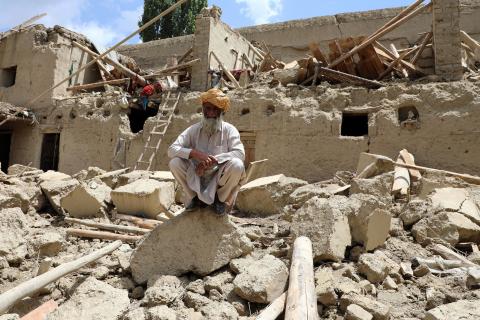On the night of August 31, 2025, a powerful 6.0-magnitude earthquake struck eastern Afghanistan, unleashing devastation across the provinces of Kunar and Nangarhar. The quake, centered just 27 kilometers east of Jalalabad, left at least 622 people dead and more than 1,500 injured, according to the Taliban-run Afghan Interior Ministry. As rescue teams combed through the rubble of collapsed homes and helicopters ferried the wounded to hospitals, the nation faced yet another tragedy in a region already grappling with severe humanitarian challenges. This article delves into the details of the earthquake, its immediate aftermath, the ongoing rescue efforts, Afghanistan’s vulnerability to seismic disasters, and the broader implications for a country struggling to recover from decades of conflict and economic hardship.
The Night the Earth Shook
The earthquake struck just before midnight local time, catching residents of eastern Afghanistan off guard as they slept in their homes. The epicenter, located near Jalalabad in Nangarhar province, was at a shallow depth of 10 kilometers, amplifying the destructive force of the quake. The United States Geological Survey (USGS) reported that the tremor was felt as far away as Islamabad, Pakistan, and northern India, including Delhi, underscoring its intensity. Aftershocks, ranging from 4.3 to 5.0 in magnitude, continued to rattle the region into Monday morning, September 1, 2025, complicating rescue efforts and heightening fears among survivors.
In Kunar province, the hardest-hit area, the quake razed three entire villages and caused significant damage to countless others. The majority of the fatalities—610—were reported in Kunar, with an additional 12 deaths in Nangarhar. Over 1,500 people were injured, many critically, as mud-brick homes, common in rural Afghanistan, collapsed under the force of the tremor. Videos circulating on social media showed scenes of chaos: rescuers digging through debris, survivors weeping over lost loved ones, and helicopters airlifting the injured to hospitals. One survivor, Sadiqullah, shared a harrowing account with the Associated Press, describing how he was awakened by a “loud boom” and managed to save three of his children before his home’s roof collapsed, killing his wife and two sons. “My father is injured and in hospital with me,” he said, his voice heavy with grief. “We were trapped for three to four hours until people from other areas arrived and pulled me out.”
The shallow depth of the quake, combined with the poor construction quality of rural homes, contributed to the high casualty count. Many buildings in Kunar and Nangarhar are made of mud bricks and wood, materials that offer little resistance to seismic forces. The destruction was particularly severe in remote mountainous areas, where access to roads was limited, and monsoon rains further hampered rescue operations. The Taliban government, in a statement, expressed profound sorrow for the loss of life and mobilized military and civilian teams to assist in the relief efforts. However, the scale of the disaster overwhelmed local resources, highlighting Afghanistan’s ongoing struggle to respond to natural calamities.
Rescue and Relief Efforts: A Race Against Time
In the immediate aftermath of the earthquake, rescue operations were launched with urgency. The Taliban’s Ministry of Defense, Interior, and Public Health deployed teams to Kunar and Nangarhar, focusing on airlifting the injured to Nangarhar Regional Hospital in Jalalabad. The military conducted 40 flights to transport over 420 wounded and deceased individuals, a testament to the scale of the crisis. Helicopters buzzed over the rugged terrain, navigating treacherous conditions to reach remote villages where survivors were trapped under rubble.
Local media outlet TOLOnews reported scenes of desperation at hospitals, where families gathered to check on loved ones. The influx of patients overwhelmed medical facilities, which were already under strain due to Afghanistan’s limited healthcare infrastructure. Doctors and nurses worked tirelessly, but the lack of adequate supplies and equipment posed significant challenges. “The number of casualties and injuries is high, but since the area is difficult to access, our teams are still on site,” said Sharafat Zaman, a spokesperson for the Afghan Public Health Ministry.
The Red Cross and other humanitarian organizations began distributing relief materials, including water, food, and shelter, to those displaced by the quake. Alexander Matheou, the International Federation of Red Cross and Red Crescent Societies (IFRC) regional director for Asia Pacific, emphasized the immediate needs: “The short-term needs are water, shelter, food.” However, the Taliban’s foreign office confirmed that, as of Monday morning, no foreign governments had extended formal offers of aid, a stark contrast to previous disasters where international support was more forthcoming. This lack of external assistance compounded the challenges faced by rescue teams and survivors, who were left to rely on Afghanistan’s limited resources.
The ongoing aftershocks added another layer of complexity to the rescue efforts. In Kunar, where entire villages were reduced to rubble, rescuers worked cautiously, aware that additional tremors could trigger further collapses. Landslides, triggered by the quake and exacerbated by monsoon rains, blocked roads, making it difficult to reach isolated communities. The United Nations estimated that nearly half a million people likely experienced strong to very strong shaking, which can cause significant damage to poorly built structures. The combination of these factors turned the rescue operation into a race against time, with fears that the death toll could rise as more remote areas reported casualties.
Afghanistan’s Seismic Vulnerability
The August 31 earthquake was not an isolated event but part of a pattern of seismic activity that has plagued Afghanistan for decades. The country lies in the Hindu Kush mountain range, near the junction of the Indian and Eurasian tectonic plates, making it one of the most seismically active regions in the world. This geological setting renders Afghanistan prone to frequent and deadly earthquakes, particularly in its eastern and western provinces. The shallow depth of the 2025 quake, at just 10 kilometers, amplified its destructive potential, as shallow quakes tend to cause more surface damage than deeper ones.
Afghanistan’s vulnerability to earthquakes is exacerbated by its socio-economic conditions. Decades of conflict, political instability, and economic hardship have left the country ill-equipped to prepare for or respond to natural disasters. Rural homes, often constructed with mud bricks and wood, are particularly susceptible to collapse during seismic events. The lack of modern building codes and enforcement further increases the risk, as seen in the destruction of entire villages in Kunar.
This was not the first time Afghanistan has faced such a tragedy. In June 2022, a 6.1-magnitude earthquake struck the eastern region, killing over 1,000 people and injuring thousands more. The following year, in October 2023, a series of 6.3-magnitude quakes in Herat province claimed between 1,500 and 4,000 lives, depending on estimates from the United Nations and the Taliban government. These disasters underscored the fragility of Afghanistan’s infrastructure and the challenges of mounting effective relief efforts in a country already stretched thin by humanitarian crises.
The 2025 earthquake, described as one of Afghanistan’s deadliest since 2022, added to the nation’s litany of natural disasters. The high casualty count and widespread destruction highlighted the urgent need for improved disaster preparedness, including stronger building standards, better early warning systems, and enhanced coordination between local and international aid agencies. However, implementing such measures in a country grappling with poverty, conflict, and political isolation remains a daunting challenge.
The Humanitarian Crisis: A Compounding Tragedy
The earthquake struck at a particularly precarious time for Afghanistan, which is already grappling with one of the world’s most severe humanitarian crises. The United Nations estimates that more than half of Afghanistan’s 42 million people are in urgent need of humanitarian aid, a situation worsened by a sharp decline in international assistance since the Taliban’s return to power in 2021. Humanitarian funding for Afghanistan has plummeted from $3.8 billion in 2022 to just $767 million in 2025, leaving critical needs unmet.
The reduction in aid is partly due to political factors. Under President Donald Trump’s second administration, the United States, which provided 45% of Afghanistan’s humanitarian aid in 2024, has suspended or eliminated nearly all contributions. Several European countries, including Britain, France, and Sweden, have also scaled back their assistance, citing concerns over the Taliban’s governance and human rights record. Only Russia has formally recognized the Taliban as Afghanistan’s official government, further isolating the country on the global stage.
This decline in aid has left Afghanistan ill-prepared to respond to disasters like the August 31 earthquake. The country’s healthcare system, already strained by years of conflict and underfunding, struggled to cope with the influx of injured patients. Hospitals in Jalalabad and surrounding areas faced shortages of medical supplies, beds, and trained personnel, forcing doctors to make difficult decisions about who to treat first. The lack of international aid also meant that relief efforts relied heavily on local resources, which were insufficient to meet the scale of the crisis.
Beyond the immediate impact of the earthquake, Afghanistan faces ongoing challenges that compound the tragedy. The country has endured four consecutive years of drought, which has devastated agricultural production and left millions food insecure. The Famine Early Warning Systems Network, established by the United States Agency for International Development, reported that below-average crop yields and reduced livestock income have limited Afghans’ ability to stock food for the winter. Additionally, the return of over 2.3 million Afghans from Iran and Pakistan in 2025 has strained resources further, as many returnees lack access to housing, employment, or basic services.
The earthquake, therefore, is not just a natural disaster but a compounding tragedy for a nation already on the brink. The Taliban government has called on international organizations to provide assistance, but the lack of formal offers as of September 1, 2025, suggests that help may be slow to arrive. Humanitarian agencies, including the World Health Organization (WHO), have pledged to support the treatment of the wounded and assess urgent health needs, but their efforts are hampered by limited funding and logistical challenges.
The Human Toll: Stories of Loss and Resilience
Behind the staggering statistics of 622 deaths and over 1,500 injuries are countless stories of loss, survival, and resilience. In Kunar, entire families were wiped out as their homes collapsed in the dead of night. Survivors like Sadiqullah, who lost his wife and two sons, faced the unimaginable task of rebuilding their lives amid grief. Others, like those airlifted to hospitals, clung to hope as medical teams worked to save them. The emotional toll was evident in hospitals, where TOLOnews reported scenes of “screaming” and “sobbing” as families searched for loved ones.
Yet, amid the tragedy, stories of resilience emerged. Volunteers and local residents joined rescue teams, digging through rubble with their hands to free trapped survivors. In one village, a group of neighbors worked through the night to rescue a family of five, pulling them from the debris just before dawn. These acts of courage underscored the strength of Afghan communities, even in the face of overwhelming loss.
The earthquake also highlighted the vulnerability of Afghanistan’s rural population. Many of the affected villages in Kunar and Nangarhar are remote, accessible only by narrow roads or helicopter. The destruction of homes left thousands homeless, with survivors facing the prospect of rebuilding in a region where resources are scarce. The onset of winter, combined with ongoing drought, raises fears of further hardship for those displaced by the quake.
The Global Response: A Call for Solidarity
The lack of immediate international aid offers has drawn attention to Afghanistan’s growing isolation on the global stage. The Taliban’s return to power in 2021 has complicated diplomatic relations, with many countries hesitant to engage directly with the regime. However, humanitarian organizations have emphasized that aid should be separated from politics, as the needs of ordinary Afghans transcend governmental disputes. The United Nations and agencies like the Red Cross have called for urgent support, warning that delays could exacerbate the crisis.
The WHO’s Afghanistan team, active on the ground, tweeted on September 1, 2025: “As reports of deaths and injuries from the #earthquake in eastern region of #Afghanistan continue to emerge, @WHOAfghanistan teams are on the ground in hospitals and health facilities, supporting the treatment of the wounded and assessing urgent health needs.” This commitment, while vital, underscores the need for broader international cooperation to address the scale of the disaster.
The earthquake also serves as a reminder of the importance of global solidarity in times of crisis. Afghanistan’s challenges—poverty, conflict, drought, and now natural disasters—are interconnected, requiring a coordinated response from the international community. While political differences may complicate aid delivery, the human cost of inaction is clear: thousands of lives hang in the balance, and delays could lead to further suffering.
Looking Ahead: Rebuilding and Resilience
As Afghanistan grapples with the aftermath of the August 31 earthquake, the path to recovery will be long and arduous. Rebuilding homes, schools, and infrastructure in Kunar and Nangarhar will require significant resources, both financial and logistical. The Taliban government has pledged to provide comprehensive support, but its capacity to deliver is limited without international assistance. The decline in humanitarian aid, combined with the country’s economic challenges, poses a significant barrier to recovery.
Long-term solutions must address Afghanistan’s underlying vulnerabilities. Strengthening building codes, particularly in rural areas, could reduce the risk of future disasters. Investing in early warning systems and disaster preparedness programs could also save lives, though such initiatives require funding and expertise that Afghanistan currently lacks. International organizations, including the United Nations and World Bank, could play a critical role in supporting these efforts, provided they can navigate the political complexities of working with the Taliban.
For the survivors, the focus is on immediate needs: shelter, food, water, and medical care. The Red Cross and other agencies are working to meet these demands, but the scale of the crisis requires a sustained effort. The coming weeks will be critical, as winter approaches and the risk of disease and malnutrition grows among displaced populations.
Conclusion
The August 31, 2025, earthquake in eastern Afghanistan was a devastating blow to a nation already burdened by conflict, poverty, and environmental challenges. The loss of 622 lives, with over 1,500 injured, underscores the fragility of life in one of the world’s most vulnerable regions. The destruction of homes and villages, coupled with the lack of immediate international aid, has left Afghanistan facing an uphill battle to recover.
Yet, amid the tragedy, the resilience of Afghan communities shines through. From the volunteers digging through rubble to the medical teams working around the clock, the response to the earthquake reflects the strength and determination of a people accustomed to adversity. The international community now faces a critical test: will it step up to support Afghanistan in its hour of need, or will political divisions continue to hinder aid efforts?
The earthquake is a stark reminder of Afghanistan’s seismic vulnerability and the urgent need for global cooperation to address humanitarian crises. As the nation mourns its losses and begins the long process of rebuilding, the world must not turn away. The people of Kunar and Nangarhar, like all Afghans, deserve the chance to recover and rebuild, supported by a global community that recognizes their shared humanity.







